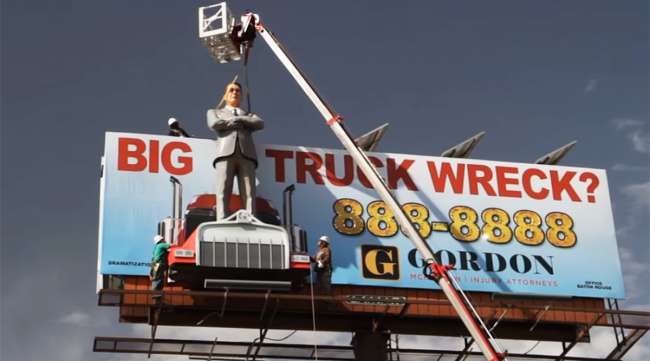Louisiana Legislators Target Billboards That Demean Truckers

Louisiana’s trucking industry is pushing for a state moratorium on new highway billboards, in part because truckers are angry about trial attorney road signs that demean truckers over injury claims.
The proposals, Senate Bill 211 and House Concurrent Resolution 4, mostly are being touted as a way to make highways more scenic and trim driver distractions cited in thousands of accidents.
The state has about 7,000 billboards, which backers of the bills say account for a hefty percentage of the total nationwide.
'STAGED ACCIDENT' CASE: Plaintiffs ask for dismissal
“They are visual clutter,” said state Sen. Conrad Appel (R-Metairie) and sponsor of the Senate measure. “When you see billboard after billboard after billboard, it is not good. It is ugly.”
Louisiana's trucking industry is pushing for a state moratorium on new highway billboards, in part because truckers are angry about trial attorney road signs that "demonize" truckers over injury claims. https://t.co/t6bpFEMdjs — The Advocate (@theadvocatebr) April 5, 2019
Rep. Jack McFarland (R-Jonesboro) and sponsor of the House measure, said voters are fed up. “If you listen to my constituents, they are tired of seeing all these billboards pop up,” McFarland said. “Everyone agrees that you can’t go 500 feet without seeing a billboard now.”
A resolution, while different from a state law, can have an impact on government operations.
Both bills face uphill battles, largely because they will run up against Lamar Advertising Co., a 117-year-old international firm based in Baton Rouge and one of the largest of its kind.
“We are concerned about the impact,” said Hal Kilshaw, vice president of governmental relations for Lamar.
The proposals are awaiting action in the Senate and House transportation committees.
The two-month legislative session starts April 8. The group behind the push is the Louisiana Motor Transport Association, which has set up a page on its website that encourages viewers to urge House and Senate members to back the bills.
The association represents about 350 trucking firms and has a visible presence in the Legislature, as does Lamar.
Chance McNeely, executive director of the group, said putting a cap on the number of billboards will make highways safer. “They are inherently distracting,” McNeely said. “They exist to distract.”
Lamar has annual revenue of about $1.6 billion. Kilshaw said the company accounts for 80-90% of the state’s billboards, with trial attorneys responsible for nearly 1,000 of them. He said he has heard that the bills may be aimed in part at advertising by trial attorneys, who often target big trucks.
“Obviously, we are not going to attribute any motives to the sponsors,” Kilshaw said.
Kilshaw also said billboards offer a path, cheaper than radio or TV, for firms to get their message out and that company surveys show motorists are not bothered by the displays.
“They appreciate the local advertising on the billboards,” Kilshaw said.
Using the bills to zero in on injury attorneys is an unofficial part of the campaign and not the pitch used by the bill sponsors. “I personally don’t care a hoot about their content,” Appel said. “I think billboards are probably worse than litter on our highways because not only do they scream that we don’t take pride in our state, but they also cause accidents.”
Accidents involving big trucks are part of the pitches used by high-profile attorneys in Baton Rouge and elsewhere.
“You need an attorney who isn’t afraid to fight the big truck companies,” Gordon McKernan’s website says.
Spencer Calahan, another attorney, says on his website that collisions involving 18-wheelers and dump trucks “nearly always mean catastrophic injuries and massive vehicle damage for the drivers of passenger vehicles and motorcycles.”
In an e-mail, Calahan said his firm has no billboards and that he does not care for them.
#TakeBackOurHighways Call your legislators!https://t.co/vkBGlykROB — LA Motor Transport Assn., Inc. (@TruckinginLA) April 5, 2019
“I can understand why the trucking industry would be upset,” he said. Officials of McKernan’s firm did not respond to a request for comment.
Permits cost $20. Truckers say the billboard industry pays the state about $145,000 per year, which is not even enough to cover administrative costs.
McFarland’s resolution would increase costs of the permits.
It would require billboards to be 2,000 feet apart, double the current rule, and be placed within 3 miles of the establishment it is advertising, a major sticking point for opponents.
He said the state has ample authority to regulate the billboard industry through the state Department of Transportation and Development.
“What I am saying is, no more,” McFarland said. “We have 7,000. Let’s stop.”
Distributed by Tribune Content Agency, LLC




